Solar and Electric Vehicles: A Match Made In Heaven
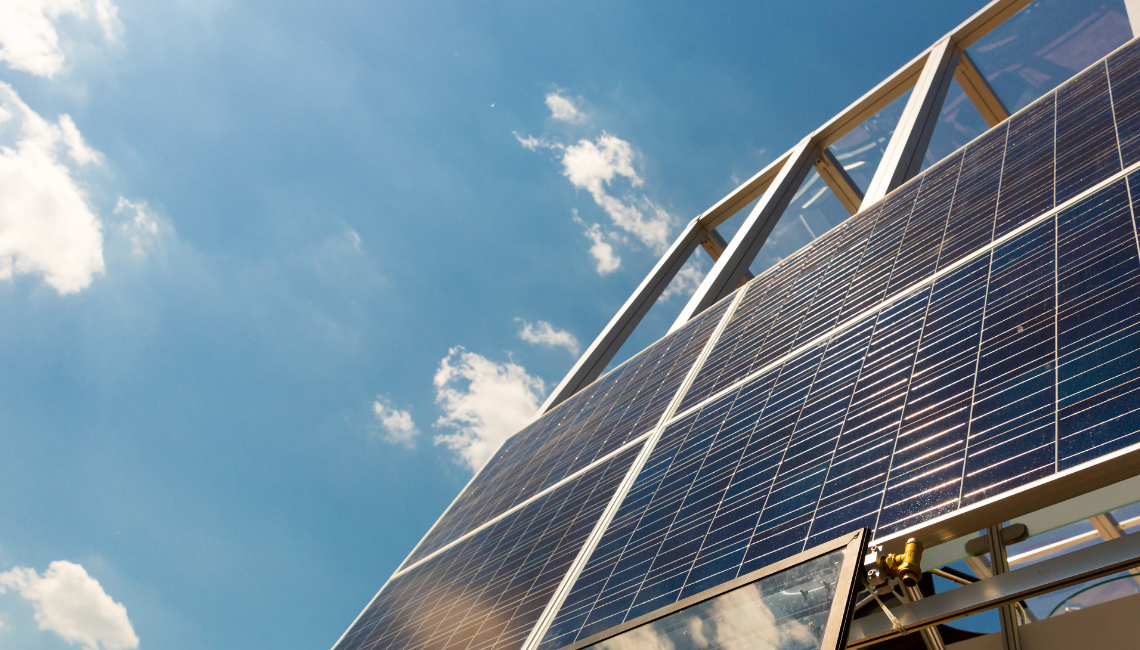
Our resident energy expert James Allston gets excited by Solar and EV’s
Solar technology has progressed a long way from the first solar cells created in 1956. Yet when talking with my tech savvy, EV owning friend Michael about solar PV, I was surprised to learn he hadn’t got on the solar bandwagon. He had been putting it off, waiting for the perfect time to install, “maybe with batteries”, “maybe when the price drops again”. He’d looked into it again recently, and since the latest clamp down of government rebates for renewable energy it was questionable whether it made sense right now.
Ok, fair point. But our recent analysis suggests, and as the title indicates, that solar and EV are a match made in heaven. So in spite of government rebate changes you will make savings, and great ones if you own an EV.
By EV charging with solar power, solar financials go from “meh” to “yeah”
This blog covers some of the basics of solar, enough to explain how EV charging with solar power is a bit of a game changer and details the modelling we’ve done.
Note: this is a blog for EV owners who wish to purchase solar outright for their homes. If you don’t have the cash for this, there’s another option for prospective solar buyers in the UK called a Power Purchase Agreement or “PPA” as it’s commonly known. That is a different story which we’ll address in another blog soon.
How solar saves you money
There are three parts to how solar saves you money.
- Generation Feed-in Tariff (FIT) – you’re paid for all the energy you generate
- Export FIT – you’re paid for the energy you export
- Self-consumption of solar power – you make savings by buying less grid electricity
Generation Feed-in Tariff
The generation FIT is based on your meter readings of electricity generated. Your electricity supplier will pay you a set rate for each unit (a kWh) of electricity you generate, as mandated by the government.
This portion is effectively a government incentive for solar. It was once very generous, but these days, due to the low cost of solar and a general level of antipathy towards it by the current government, the incentive only amounts to just over 4 p/kWh.
Details on the FIT rules can be found here. In summary though, you will need to register for the FIT and then payments are index-linked and guaranteed for 20 years.
Export FIT
You can gain a further payment from your energy supplier for any electricity you generate and don’t use yourself. This accounts for the value of the energy you export and is roughly equal to what a large utility-scale generator is paid for their energy. “Normally,” export energy amounts are calculated as the amount generated less the amount consumed, or is simply measured.
But for residential solar installations in the UK the amount exported is not measured. Instead, the exported energy is assumed to be 50% of your generated energy thus having no relationship to the amount you consume. (Has the penny dropped yet?)
This effectively means your Export FiT works as a little top up to your Generation FiT as it relatively fixed. The Energy Saving Trust has more information. This payment is also index-linked.
Self-consumption of solar energy
Finally, solar will make further savings on your electricity bills because you are generating electricity for free that you can self-consume. More simply, you don’t have to buy as much electricity from your energy supplier. The amount you save will vary depending how much of the solar electricity you use on site. Because of the way Export FiTs are calculated, increasing the amount of solar self-consumption can increase your energy savings without affecting your Export FiT payments. Small changes to when you use electricity can amount to substantial savings over the course of a year. This includes charging the EV in the daytime of course.
A day in the life of your solar powered home and EV�
The following graphs show you how the savings work on a typical sunny spring day.
- First, a base case – no solar
- Second, a solar powered home but with night time EV charging
- Third, a solar powered home and daytime EV charging
No solar generation
With no solar generated electricity, you pay for everything you use. Depending on your chosen tariff you may be paying less for electricity at night than you are during the day. In this example we’ve assumed that you’re on an Economy 7 and charging at night.
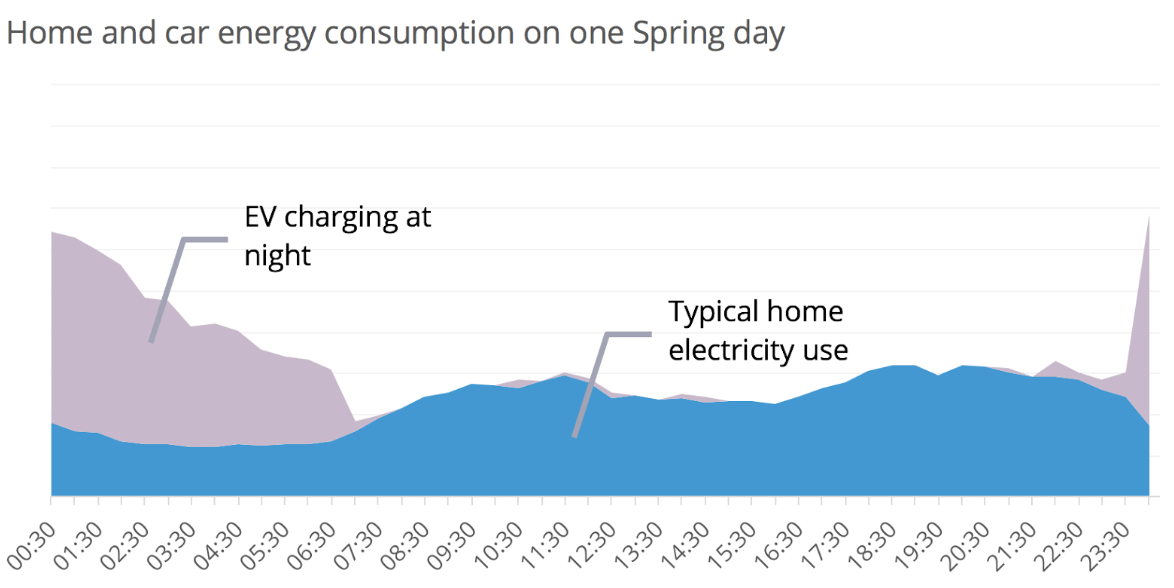
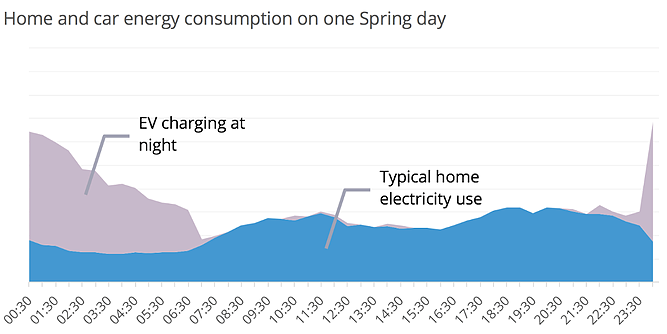
Solar generation but night time EV charging
When you have solar panels you pay for the electricity you use through the evening and night. During the daylight hours you will be using your own solar electricity. And even being paid for the electricity you generate. In this case we’ve shown how charging your EV at night might look if you’re on an Eco7 tariff. This of course is not optimizing for self consumption.
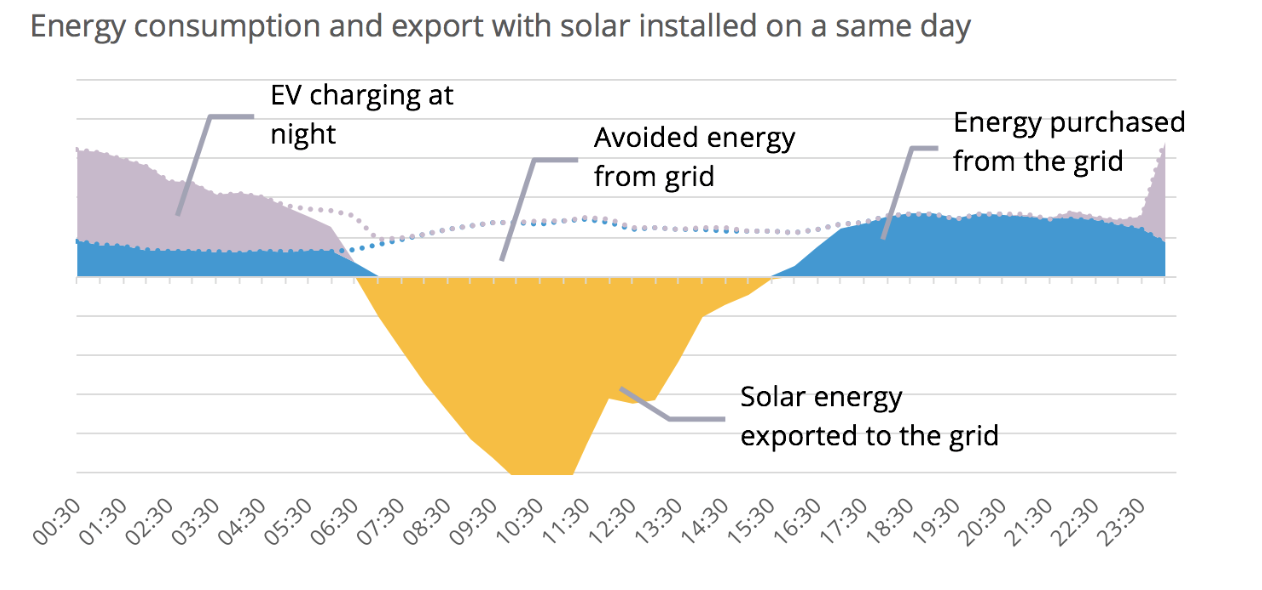
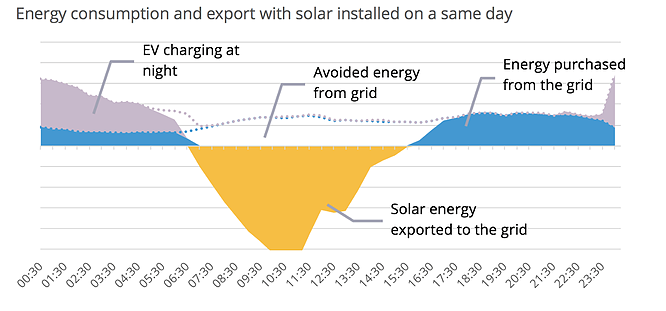
Solar generation – EV charging in the day
To optimize for self consumption you need to charge your EV during the day. This makes best use of the electricity you have generated. Even though you’re exporting a lot less, your Export FiT will remain unchanged while your savings from self-consumption will go through the roof.
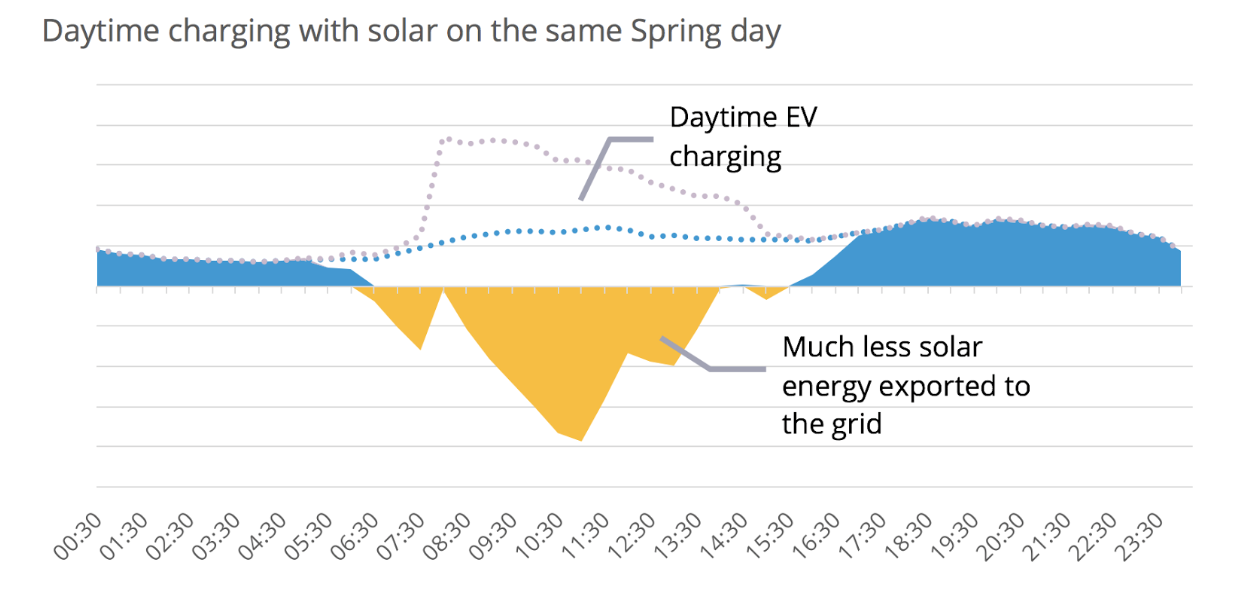
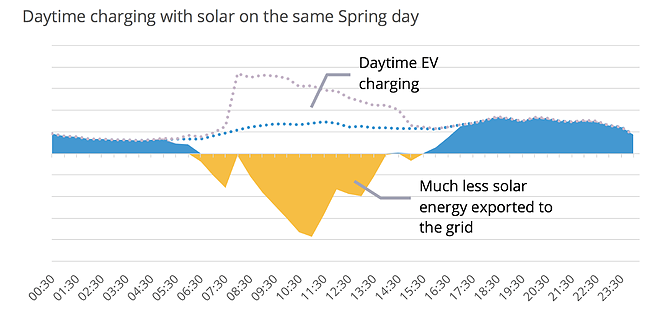
Checking the numbers
“Looks like there’s something in this, but show me the numbers” I hear you say. Ask and you shall receive. We have tested different 7 scenarios that consider the tariff type, whether or not solar is installed and what time the EV is charged. Below are the conclusions we reached:
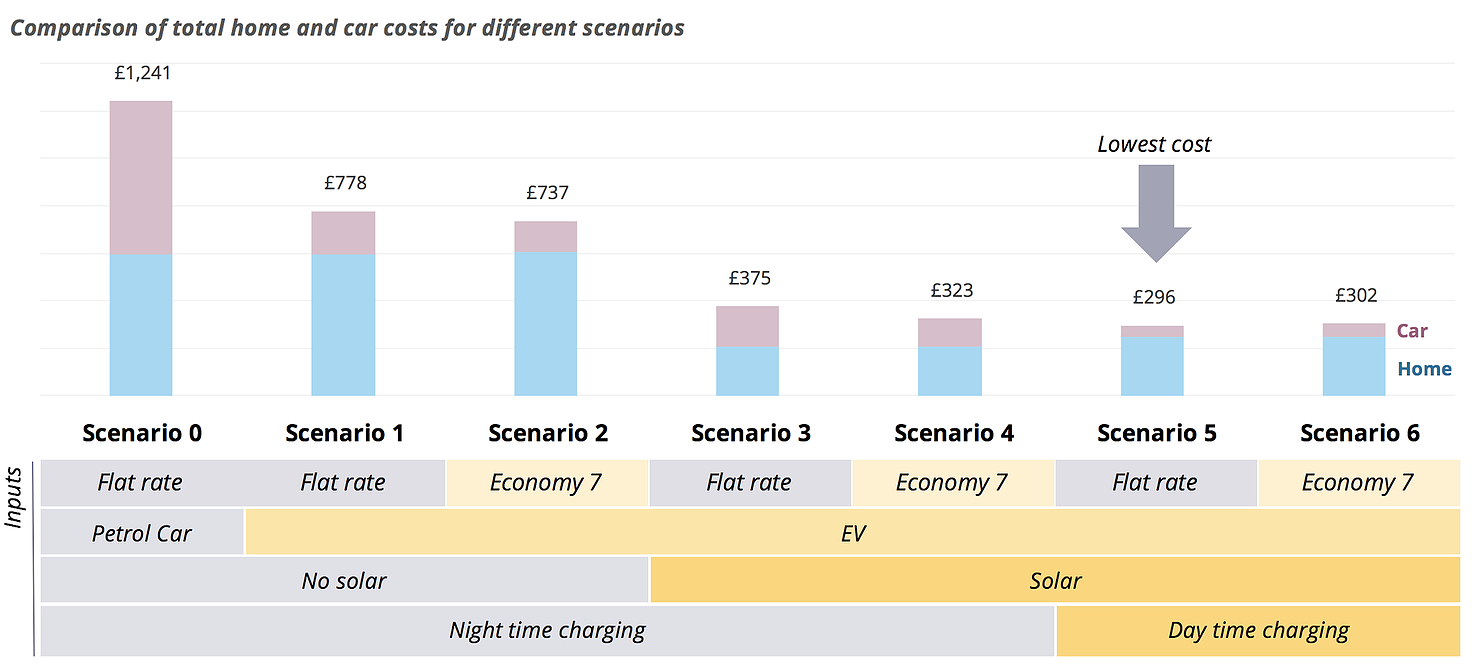
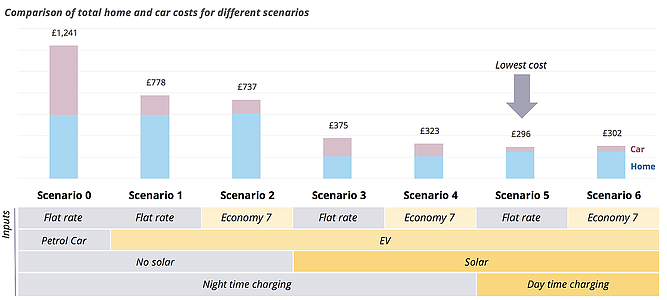
In all cases against the base case of flat rate home consumption and a mid-sized petrol car we see significant savings, but around £460 can be attributed to just driving an EV. Installing solar saves at least another £400.
Scenario 5 with flat rate tariff, solar installed and day time charging gives the best outcome. Here less than £300 needs to be paid to run the home and car on electricity!
What about payback?
Payback period is usually the best financial metric to determine whether solar makes sense for a given home. Simple payback is calculated as the total investment cost divided by the annual savings and most people search for paybacks of 10 years or better. Payback period is where you see why solar charging really shines:
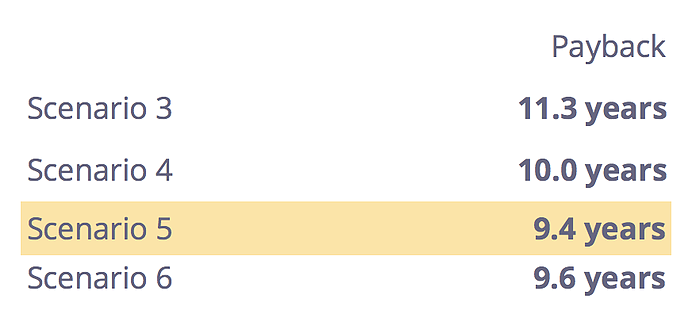
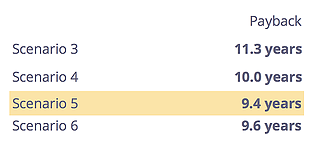
In a “normal home” with no EV, solar payback periods would be equivalent to Scenario 3. Here you can expect rather yawn-inducing paybacks for solar of 11.3 years. But Scenarios 5 and 6 deliver deal creating paybacks of around 9.5 years! When solar can last for 20-30 years, that’s a lot of free energy.
Note: to calculate paybacks, Scenario 1 was used as the base case
To Eco7 or not to Eco7 (with Solar and an EV)? That is the question�
At first glance a flat rate tariff is the best option for a solar charging EV owner. But that assumes 100% of your home EV charging is during sunlight hours in the middle of the day. We think that’s unrealistic unless you’re a home bod.
Even though you can potentially save more with a flat rate tariff, we think an Economy 7 tariff is still the best option. This is because it gives you more options on when to charge the EV and still make savings and creates a lot less down side if you don’t manage to charge with the sun. With Economy 7 you can treat charging the EV on solar energy as more of a bonus.
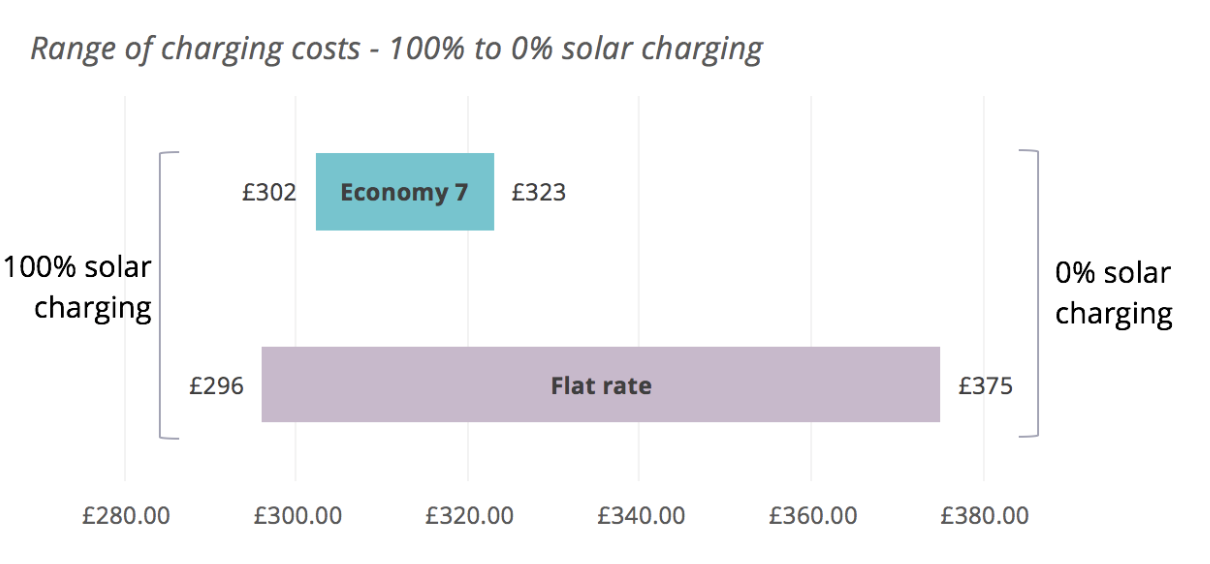
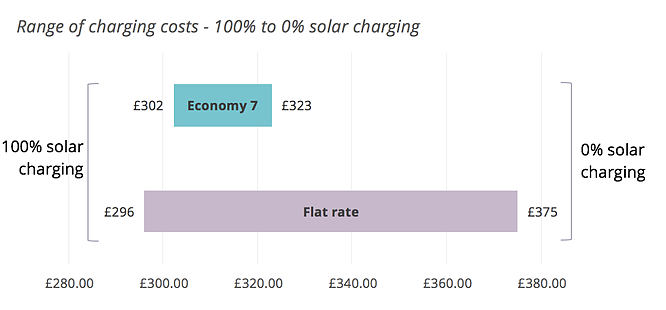
In conclusion�
Hopefully now Michael, and you, can see the financial value of installing solar and charging your EV with it. As an EV owner, getting solar on your home is really going to make a lot of financial sense. Not to mention it also reduces your carbon footprint and increases your energy independence.
Evenergi plans to soon build a solar calculator into its energy monitor. We’ll be able to give you super accurate investment cases based on your real energy data.
Also, sign up to ‘Charge Together’ and join the solar group-buy campaign for savings on buying solar outright.
Assumptions used in this article:
For those that love the nitty gritty details, here are the assumptions we used. Home: located in the South East using 4300kWh p.a, assumed average Class 1 profile (from Exelon) | Petrol Car: Mid-sized car with 8.5L/100km efficiency driven 7900 miles per year | EV: Nissan Leaf 30kWh driven 7900 miles per year, 80% home charged | Solar: New 3.5kW solar system costing £4550 | Feed-in Tariffs: The current rates for Feed-in Tariffs. i.e. Generation FiT: 4.07 p/kWh and Export FiT: 5.03 p/kWh | Tariffs used in comparison: Flat rate tariff: Unit rate: 11.86 p/kWh Standing charge: 23.65 p/day Economy 7 tariff: Day unit rate: 12.91 p/day Night unit rate: 8.13 p/day Standing charge: 23.65 p/day